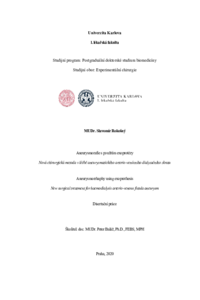Aneurysmorafie s použitím exoprotézy. Nová chirurgická metoda v léčbě aneuryzmatického arterio-venózního dialyzačního zkratu.
Aneurysmorrhaphy using exoprothesis. New surgical treatment for haemodialysis arterio-venous fistula aneurysm.
dissertation thesis (DEFENDED)

View/
Permanent link
http://hdl.handle.net/20.500.11956/122598Identifiers
Study Information System: 172357
CU Caralogue: 990023871160106986
Collections
- Kvalifikační práce [4674]
Author
Advisor
Referee
Grus, Tomáš
Tomka, Ján
Faculty / Institute
First Faculty of Medicine
Discipline
-
Department
3rd Department of Surgery First Faculty of Medicine and University Hospital Motol
Date of defense
5. 10. 2020
Publisher
Univerzita Karlova, 1. lékařská fakultaLanguage
Czech
Grade
Pass
Keywords (Czech)
aneurysma, arterio-venózní fistula, aneurysmorafieKeywords (English)
aneurysm, arterio-venous fistula, aneurysmorrhaphyÚvod: Výskyt aneurysmatu arterio-venózní fistule (AAVF) u hemodialyzovaných pacientů je 7-43 % a k operační léčbě by mělo být indikováno symptomatické AAVF. Doposud není shoda v tom, která z operačních technik je metodou volby a zda má snížení průtoku v AAVF pozitivní vliv na remodelaci srdce u vysoko-průtokového AAVF. Cíle: (1) zavedení nové chirurgické techniky - aneurysmorafie s exoprotézou (AsE) do klinické praxe a ověření její efektivity z hlediska průchodnosti a pooperačních komplikací; (2) analýza vlivu AsE na remodelaci srdce u vysoko-průtokového AAVF; (3) systematický přehled a metaanalýza chirurgických metod v léčbě AAVF s cílem najít nejoptimálnější operační techniku. Metodika: (1) retrospektivní analýza prospektivně získaných operačních a pooperačních parametrů, hodnocení průchodnosti Kaplan-Meierovou metodou, hodnocení včasných a pozdních komplikací; (2) retrospektivní analýza prospektivně získaných echokardiografických parametrů před a po AsE; (3) systematický přehled a metaanalýza (PRISMA doporučení) - registrovaná v systému PROSPERO (CRD42016029692). Výsledky: (1) primární asistovaná průchodnost AsE je 80 % v 1 roce, infekční komplikace 4.5 % a recidiva AAVF 0 %; (2) AsE vede k reverzibilní srdeční remodelaci jen u pacientů se zvýšeným srdečným indexem (> 3.9 l/min/m2 ); (3) 795...
Introduction: Haemodialysis arterio-venous fistula aneurysm (AAVF) prevalence varies between 7-43%. When they are symptomatic, they should be referred for treatment. It is unclear which is the optimal surgical treatment and if fistula flow reduction is beneficial for heart remodeling in patients with high-flow AAVF. Aims: (1) introduction of a new surgical technique - aneurysmorrhaphy using exoprothesis (AuE) and evaluation of its patency and complication rates. (2) analysis of flow reduction impact on heart remodeling in high-flow AAVF. (3) systematic review and meta- analysis of various surgical techniques to identify the best treatment option of haemodialysis arterio-venous fistula aneurysm. Methods: (1) retrospective analysis with prospectively collected surgical and postoperative data, patency evaluation using Kaplan - Meier curve, early and late complication rates analysis. (2) retrospective analysis prospectively collected echocardiographic parameters before and after surgery. (3) systematic review and meta- analysis following the PRISMA guidelines - registered in the international prospective register of prospective reviews PROSPERO (registration number: CRD42016029692). Results: (1) primary assisted patency rate at 12 months was 80 %, infection rate was 4.5 % and AAVF recurrence rate was 0...
